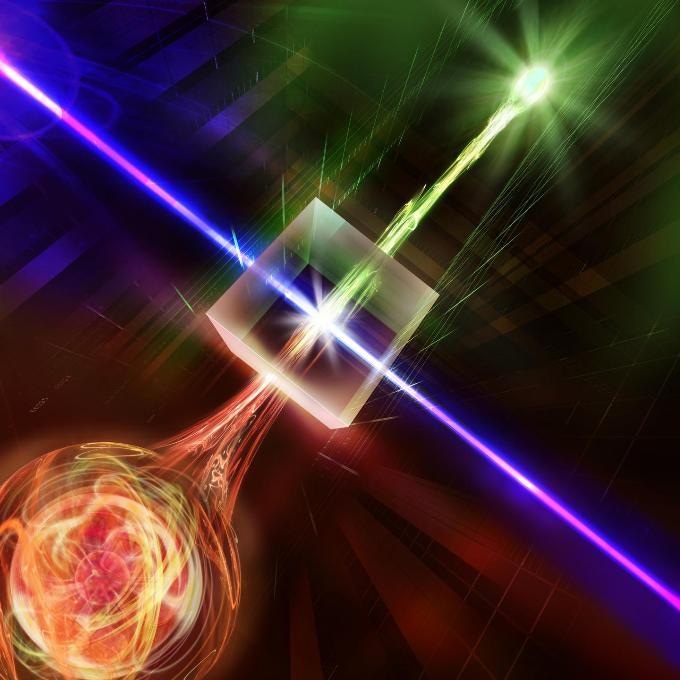Sep 27 2019
The outcomes of a new study at the U.S. Army’s CCDC Army Research Laboratory takes mankind one step closer to the quantum internet. Quantum internet could provide the sensing, timekeeping, and military security capabilities that cannot be offered by conventional networking methods.
 Researchers at the University of Innsbruck, funded by the U.S. Army, achieved a record for the transfer of quantum entanglement between matter and light—a distance of 50 km was covered using fiber optic cables. Researchers said this brings the quantum internet a step closer. In a nonlinear crystal illuminated by a strong laser, the photon wavelength was converted to the optimal value for long-distance travel. (Image credit: IQOQI Innsbruck, Harald Ritsch)
Researchers at the University of Innsbruck, funded by the U.S. Army, achieved a record for the transfer of quantum entanglement between matter and light—a distance of 50 km was covered using fiber optic cables. Researchers said this brings the quantum internet a step closer. In a nonlinear crystal illuminated by a strong laser, the photon wavelength was converted to the optimal value for long-distance travel. (Image credit: IQOQI Innsbruck, Harald Ritsch)
The Center for Distributed Quantum Information at the U.S. Army’s CCDC Army Research Laboratory is funded and run by the lab’s Army Research Office. At the center, researchers from the University of Innsbruck were observed to realize a record for the transfer of quantum entanglement between light and matter—a distance of 50 km with the help of fiber optic cables.
The phenomenon of entanglement is a correlation that can be developed between quantum entities like qubits. Upon entangling two qubits and performing measurements on one of them, the result of a measurement performed on the other is influenced, even if the second qubit is physically located very far.
This [50 kilometers] is two orders of magnitude further than was previously possible and is a practical distance to start building inter-city quantum networks.
Dr Ben Lanyon, Experimental Physicist, University of Innsbruck
Dr Lanyon is the principal investigator for the study, the results of which have been reported in the Nature journal Quantum Information.
Intercity quantum networks would be formed of far-away network nodes made of physical qubits, which are however entangled in spite of the huge physical separation. According to the researchers, such a distribution of entanglement is crucial for setting up a quantum internet.
The demonstration is a major step forward for achieving large scale distributed entanglement. The quality of the entanglement after traveling through fiber is also high enough at the other end to meet some of the requirements for some of the most difficult quantum networking applications.
Dr Sara Gamble, Program Co-Manager, U.S. Army Research Office
The group began the experiment using a calcium atom trapped in an ion trap. The researchers used laser beams to write a quantum state onto the ion and, at the same time, excited it to emit a photon in which quantum information is stored. Consequently, the light particle and the atom’s quantum states were entangled.
The challenge here is to send the photon over fiber optic cables.
“The photon emitted by the calcium ion has a wavelength of 854 nanometers and is quickly absorbed by the optical fiber,” stated Lanyon.
Hence, at first, his group sent the light particle via a nonlinear crystal illuminated by a powerful laser. The photon wavelength was changed to the best-suited value for long-distance travel—the current telecommunications standard wavelength of 1550 nm.
Then, the researchers sent this photon via the 50 km-long optical fiber line. Their measurements reveal that light particles and atom were still entangled despite the wavelength conversion and the distance traveled.
The choice to use calcium means these results also provide a direct path to realizing an entangled network of atomic clocks over a large physical distance, since calcium can be co-trapped with a high quality ‘clock’ qubit. Large scale entangled clock networks are of great interest to the Army for precision position, navigation, and timing applications.
Dr Fredrik Fatemi, Army Researcher, U.S. Army Research Office
Dr Fatemi also co-manages the program.